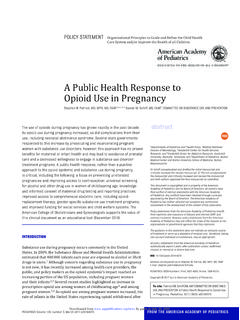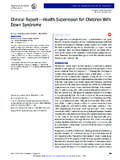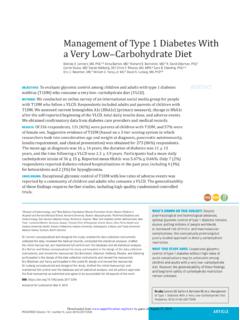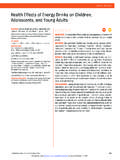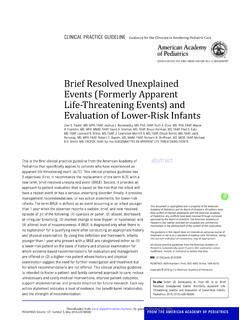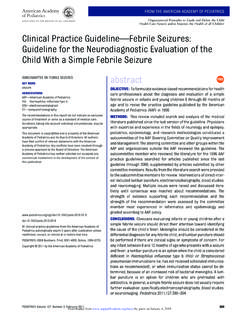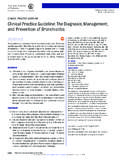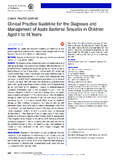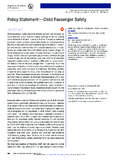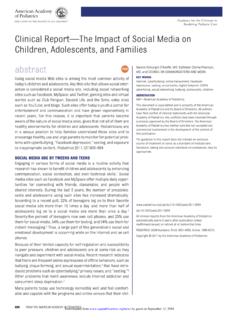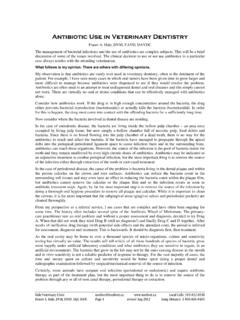Transcription of CLINICAL PRACTICE GUIDELINE The Diagnosis and …
1 CLINICAL PRACTICE GUIDELINEThe Diagnosis and Management of Acute Otitis MediaabstractThis evidence-based CLINICAL PRACTICE GUIDELINE is a revision of the 2004acute otitis media (AOM) GUIDELINE from the American Academy of Pe-diatrics (AAP) and American Academy of Family Physicians. It providesrecommendations to primary care clinicians for the management ofchildren from 6 months through 12 years of age with 2009, the AAP convened a committee composed of primary carephysicians and experts in thefields of pediatrics, family PRACTICE , oto-laryngology, epidemiology, infectious disease, emergency medicine,and GUIDELINE methodology.
2 The subcommittee partnered with theAgency for Healthcare Research and Quality and the Southern Califor-nia Evidence-Based PRACTICE Center to develop a comprehensive reviewof the new literature related to AOM since the initial evidence report of2000. The resulting evidence report and other sources of data wereused to formulate the PRACTICE GUIDELINE focus of this PRACTICE GUIDELINE is the appropriate Diagnosis andinitial treatment of a child presenting with AOM. The GUIDELINE providesa specific, stringent definition of AOM. It addresses pain management,initial observation versus antibiotic treatment, appropriate choices ofantibiotic agents, and preventive measures.
3 It also addresses recur-rent AOM, which was not included in the 2004 GUIDELINE . Decisions weremade on the basis of a systematic grading of the quality of evidenceand benefit-harm PRACTICE GUIDELINE underwent comprehensive peer review beforeformal approval by the CLINICAL PRACTICE GUIDELINE is not intended as a sole source of guid-ance in the management of children with AOM. Rather, it is intended toassist primary care clinicians by providing a framework for clinicaldecision-making. It is not intended to replace CLINICAL judgment or es-tablish a protocol for all children with this condition.
4 These recommend-ations may not provide the only appropriate approach to themanagement of this ;131:e964 e999 Allan S. Lieberthal, MD, FAAP, Aaron E. Carroll, MD, MS,FAAP, Tasnee Chonmaitree, MD, FAAP, Theodore G. Ganiats,MD, Alejandro Hoberman, MD, FAAP, Mary Anne Jackson,MD, FAAP, Mark D. Joffe, MD, FAAP, Donald T. Miller, MD,MPH, FAAP, Richard M. Rosenfeld, MD, MPH, FAAP, Xavier , MD, FAAP, Richard H. Schwartz, MD, FAAP, Pauline , MD, FAAP, and David E. Tunkel, MD, FAAP, FACSKEY WORDS acute otitis media, otitis media, otoscopy, otitis media witheffusion, watchful waiting, antibiotics, antibiotic prophylaxis,tympanostomy tube insertion, immunization.
5 BreastfeedingABBREVIATIONSAAFP American Academy of Family PhysiciansAAP American Academy of PediatricsAHRQ Agency for Healthcare Research and QualityAOM acute otitis mediaCI confidence intervalFDA US Food and Drug AdministrationLAIV live-attenuated intranasal influenza vaccineMEE middle ear effusionMIC minimum inhibitory concentrationNNT number needed to treatOM otitis mediaOME otitis media with effusionOR odds ratioPCV7 heptavalent pneumococcal conjugate vaccinePCV13 13-valent pneumococcal conjugate vaccineRD rate differenceSNAP safety-net antibiotic prescriptionTIV trivalent inactivated influenza vaccineTM tympanic membraneWASP wait-and-see prescriptionThis document is copyrighted and is property of the AmericanAcademy of Pediatrics and its Board of Directors.
6 All authorshavefiled conflict of interest statements with the AmericanAcademy of Pediatrics. Any conflicts have been resolved througha process approved by the Board of Directors. The AmericanAcademy of Pediatrics has neither solicited nor accepted anycommercial involvement in the development of the content ofthis recommendations in this report do not indicate an exclusivecourse of treatment or serve as a standard of medical , taking into account individual circumstances, may beappropriate.(Continued on last page)e964 FROM THE AMERICAN ACADEMY OF PEDIATRICSO rganizational Principles to Guide and Define the ChildHealth Care System and/or Improve the Health of all Children by guest on May 17, 2018 from by guest on May 17, 2018 from by guest on May 17, 2018 from by guest on May 17, 2018 from Key Action Statement 1A: Cliniciansshould diagnose acute otitis media(AOM)inchildrenwhopresentwithmodera te to severe bulging of thetympanic membrane (TM)ornewonset of otorrhea not due to acuteotitis externa.
7 Evidence Quality:Grade B. Strength: Action Statement 1B: Cliniciansshould diagnose AOM in childrenwho present with mild bulging of theTMandrecent (less than 48 hours)onset of ear pain (holding, tugging,rubbing of the ear in a nonverbalchild) or intense erythema ofthe TM. Evidence Quality: Grade : Action Statement 1C: Cliniciansshould not diagnose AOM in chil-dren who do not have middle eareffusion (MEE) (based on pneu-matic otoscopy and/or tympanometry).Evidence Quality: Grade B. Action Statement 2: The man-agement of AOM should include anassessment of pain.
8 If pain ispresent, the clinician should rec-ommend treatment to reduce Quality: Grade B. Strength:Strong Action Statement 3A: SevereAOM: The clinician should prescribeantibiotic therapy for AOM (bilateralor unilateral) in children 6 monthsand older with severe signs orsymptoms (ie, moderate or severeotalgia or otalgia for at least 48hours or temperature 39 C [ F]or higher). Evidence Quality: Grade : Strong Action Statement 3B: Non-severe bilateral AOM in youngchildren: The clinician should pre-scribe antibiotic therapy for bi-lateral AOM in children 6 monthsthrough 23 months of age withoutsevere signs or symptoms (ie, mildotalgia for less than 48 hours andtemperature less than 39 C [ F]).
9 Evidence Quality: Grade B. Action Statement 3C: Non-severe unilateral AOM in youngchildren: The clinician should ei-ther prescribe antibiotic therapyoroffer observation with closefollow-up based on joint decision-making with the parent(s)/caregiverfor unilateral AOM in children 6months to 23 months of age withoutsevere signs or symptoms (ie, mildotalgia for less than 48 hoursand temperature less than 39 C[ F]). When observation isused, a mechanism must be in placeto ensure follow-up and begin anti-biotic therapy if the child worsensor fails to improve within 48 to72 hours of onset of Quality: Grade B.
10 Action Statement 3D: NonsevereAOM in older children: The clinicianshould either prescribe antibiotictherapyoroffer observation withclose follow-up based on jointdecision-making with the parent(s)/caregiver for AOM (bilateral or uni-lateral) in children 24 months orolder without severe signs orsymptoms (ie, mild otalgia for lessthan 48 hours and temperature lessthan 39 C [ F]). When obser-vation is used, a mechanism mustbe in place to ensure follow-up andbegin antibiotic therapy if the childworsens or fails to improve within48 to 72 hours of onset of Quality: Grade B.
